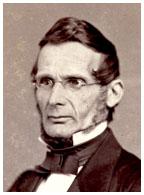To mark the 200th anniversary of Guyot’s birth, Sept. 28, the University created a small exhibition in the Frist Student Center. At the opening ceremony, admirers noted the immense impact of his work. He standardized the gathering and recording of changing weather conditions, becoming one of the founders of the U.S. Weather Bureau. He accurately measured the altitudes of mountains in eastern America and developed physical geographic maps, which had a great impact on the teaching of physical geography in the 19th century. He was a consummate explorer who organized paleontological and other expeditions, and collected thousands of specimens for display and study at Princeton.
The exhibition on his life, which continues through Oct. 26, includes artifacts of a different sort. There is Guyot’s microscope, his inkwell, and the notes taken by one of his students. An 1849 edition of Guyot’s book, The Earth and Man, also is on display.
This book (subtitle: Lectures on Comparative Physical Geography in Its Relation to the History of Mankind) is a collection of lectures Guyot gave in Boston. Guyot was a deeply religious man, and participants in Princeton’s celebration noted his desire to marry science and religion. The book did this, connecting the “physical domain” of “civilized” regions — guided by the hand of God — with progress and moral development. A century and a half later, it makes for troubling reading: “As there is a temperate hemisphere and a tropical hemisphere, we may, in the same manner, say there is a civilized hemisphere and a savage hemisphere.” Guyot describes physical features of the peoples inhabiting these different lands, writing about Caucasians: “What strikes us immediately is the regularity of the features, the grace of the lines, the perfect harmony of all the form. Such is the type of the white race ... the most pure, the most perfect type of humanity.” At the celebration of Guyot’s life, this part of his work went without comment.
Guyot’s book had both educational and political ramifications. As an award-winning 1997 book about maps and geographical concepts, The Myth of Continents, points out, Guyot’s theories influenced several generations of Princeton-trained writers and teachers. The theories also supported the notion of manifest destiny, for it was in the United States, Guyot argued, that “all the peoples of Europe may meet together, with room enough to move in.”
In its time, the book was extremely popular. Today, with different debates over science, religion, and public policy taking place, it’s still worth thinking about the full range of Guyot’s legacy.

